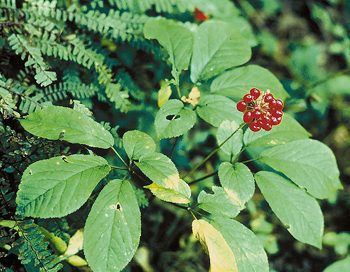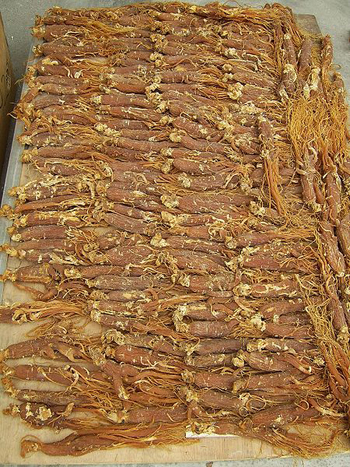Contents:
Common Names | Parts Usually Used | Plant(s) & Culture | Where Found | Medicinal Properties | Biochemical Information
Legends, Myths and Stories | Uses | Formulas or Dosages | How Sold | Warning | Resource Links | Bibliography
Scientific Names

- Panax quinquefolium L.
- Panax ginseng
- American ginseng
- Ararliaceae
- Ginseng family
Common Names
Panax quinquefolius L.:
- American ginseng
- Five fingers
- Five fingers root
- Five-leafed ginseng
- Garantogen
- Jen-shen (Chinese name)
- Ninsin
- Panax
- Pannag
- Redberry
- Sang
Panax schin-seng L.:
- Asiatic ginseng
- Chinese ginseng
- Jen-shen (Chinese name)
- Len seng (Mandarin name)
- Ren-shen (Sanskrit name)
- Wonder-of-the-world
Parts Usually Used
Panax quinquefolius L.:
- Roots
Panax schin-seng L.:
- Roots
Panax trifolius L.:
- Leaves and roots
Eleutherococcus senticosus L.: (Otherwise known as Siberian ginseng)
- Root
Description of Plant(s) and Culture

Panax quinquefolius L.:
A perennial slow growing plant with a large spindle-shaped fleshy root and a smooth erect stem;
Panax schin-seng L.: (Chinese Panax ginseng)
Asiatic ginseng is a small perennial plant; the aromatic root common only grows to a length of
Panax trifolius L.:
Known as Dwarf Ginseng: it is a globe-rooted perennial;
Eleutherococcus senticosus L.: (Otherwise known as Siberian ginseng)
In Russia today, scientists are researching many subjects. As a part of this research, the Russians have been working to find the true medicinal value of plants, and they have been trying to promote a plant of their own,
It is a stimulant, increasing the general tone of the organism, normalizing arterial pressure and reducing an elevated blood sugar level. Helps people resist bad effects of stress more effectively. This herb is not technically ginseng at all but has many of the properties of ginseng and is used the same way.
Other varieties:
Japanese ginseng (Panax japonica); and Tienchi Ginseng (Panax notoginseng), no English equivalent name, also called sanchi. Tienchi is used in processed form, never raw, available in markets in processed slices of the root called Tian Qi Pian.
Back to Top
Where Found
Panax quinquefolius L.:
Rich woods. Maine to Georgia; Oklahoma to Minnesota. Now an endangered species in much of this area. Wisconsin-grown ginseng is highly valued throughout the Orient.
Panax schin-seng L.:
Found in damp woods of Manchuria and is cultivated primarily in Korea.
Panax trifolius L.:
Rich woods. Nova Scotia to Pennsylvania, Georgia mountains; Indiana, Iowa to Minnesota.
Eleutherococcus senticosus L.: (Otherwise known as Siberian ginseng)
Grown in Siberia.
Back to Top
Medicinal Properties
Panax quinquefolius L.:
Demulcent, tonic, alterative, stimulant, carminative, stomachic, nervine, aphrodisiac
Panax schin-seng L.:
Demulcent, nervine, panacea, stimulant, stomachic, tonic
Panax trifolius L.:
Demulcent, tonic.
Eleutherococcus senticosus L.: (Otherwise known as Siberian ginseng)
Demulcent panacea, stimulant, stomachic, nervine, tonic
Back to Top
Biochemical Information
Panax quinquefolius L.:
Arabinose, calcium, camphor, gineosides, iron, mucilage, panaxosides, resin, saponin, starch, and
Panax schin-seng L.:
Arabinose, calcium, camphor, gineosides, iron, mucilage, panaxosides, resin, saponin, starch, and
Panax trifolius L.:
Arabinose, calcium, camphor, gineosides, iron, mucilage, panaxosides, resin, saponin, starch, and
Eleutherococcus senticosus L.: (Otherwise known as Siberian ginseng)
Eleuherosides
Back to Top
Legends, Myths and Stories
Used in China for over 5,000 years, ginseng was known to 9th century Arab physicians. Over
The name “panax” in the botanical name means “all-healing.” The Mandarin name for ginseng, len seng, literally means “root of man,” so named because the root resembles the shape of the human body.
It is said that the botanical name of ginseng is derived from the Greek word for panacea, because of the great reverence in which the herb is held.
Ginseng was known to Judah in the market place of Israel
Panax quinquefolius L.:
No medicinal herb is more famous than Ginseng. For over
In China for centuries, Ginseng was considered an almost magical drug, a cure for bodily woes. Among the Chinese healers Ginseng is regarded primarily as a “man’s herb” although it may be taken by both men and women. The female equivalent of Ginseng is a root called
The name Ginseng is derived from the Chinese word for “likeness of man” because its roots sometimes resemble a human figure. Ginseng’s genus name Panax, like the word panacea, comes from the Greek word panakeia, meaning “all-healing”. This refers to the plant’s reputation as a Chinese cure-all. Quinquefolium means five-fingered leaf.
Native Americans have used the root of this plant to relieve vomiting and nausea. Some tribes used it in their love potions. American colonists began using ginseng in the early 1700s. The Eclectics, 19th century physicians who rejected synthetic drugs in favor of plant medicines, recommended American ginseng as a stimulant and aphrodisiac.
Back to Top
Uses
Panax quinquefolius L.:
The root is considered demulcent, mild stimulant, tonic. Research suggests it may increase mental efficiency and physical performance, aid in adapting to high or low temperatures and stress when taken over an extended period. Ginseng’s effect is called “adapatogenic”, tending to return the body to normal.
Promotes appetite, helps dyspepsia, rheumatism, headache, lumbago, sciatica, debility, colds, coughs, bronchitis, symptoms of menopause, constipation, lung troubles, cystitis.
Native Americans in some areas used a decoction of ginseng root to relieve nausea and vomiting. Several tribes used it as an ingredient in love potions and charms. May inhibit the growth of cancerous tumors.
Panax schin-seng L.:
Used as a panacea for all ailments. Used primarily for fever, inflammatory diseases, for hemorrhage, and for blood diseases. Women take it for everything from normalizing menstruation to easing childbirth. Promotes mental and physical vigor, relieves stress, impotence, rheumatism, strengthens endocrine glands, reduces cholesterol, increases the good cholesterol (HDL) and lowers the so called bad cholesterol (LDL), normalizes bodily functions, increases energy, enhances sexual desire, improves appetite and helps digestive disturbances. Mildly stimulates the central nervous system and various glands. Helpful for coughs, colds, and various chest problems. May inhibit growth of malignant tumors.
The Chinese have used ginseng as a heart tonic, severe dyspepsia, continued fevers, old coughs, persistent vomiting in pregnancy, chronic malaria, hemorrhages, and spermatorrhea.
Panax trifolius L.:
Native Americans used tea of the whole plant for colic, indigestion, gout, hepatitis, hives, rheumatism, and tuberculosis; root was chewed for headaches, shortness of breath, fainting, nervous debility.
Used to treat impotence, (it stimulates male sex glands), stress (strengthens the adrenal glands), cocaine withdrawal, energy, diabetes, radiation protection, colds, and chest problems. Promotes lung function, enhances immune function, stimulates the appetite, and normalizing blood pressure.
Eleutherococcus senticosus L.: (Otherwise known as Siberian ginseng)
Normalizes blood pressure, relieves physical and mental stress, hardening of the arteries, angina, headaches, improved blood circulation, insomnia, treats bronchitis, chronic lung ailments, reduces blood cholesterol, increases energy and stamina, improves mental alertness and generally improves overall health.
Back to Top
Formulas or Dosages
Panax schin-seng L.:
The root of both ginseng species listed here, is collected after flowering. Use only thoroughly dried root. Make it into a tea according to your taste and use as needed. (Normally
Back to Top
How Sold
Capsules: take 1 capsule, up to 3 times daily.
Tablets, Extracts
Powder: mix 1 to
Instant granules, Ginseng liquid
Back to Top
Warning
Panax quinquefolius L.:
Some caution required, large doses are said to raise blood pressure. Do not use if you have high blood pressure.
Because it grows slowly, is rare over much of its former range and because it has been overcollected, wild plants should be left alone.
Avoid P. notoginseng in pregnancy; it may adversely affect the fetus. Although ginseng is generally safe, side effects have been reported; avoid other stimulants such as tea, coffee, and cola drinks when taking ginseng.
Panax schin-seng L.:
Some may find Chinese ginseng too stimulating, especially at bedtime. Use early in the day. High doses may cause jittery feelings. Do not exceed
Avoid use or use with care if you have high blood pressure, high fever, inflammatory conditions, or obesity.
Back to Top
Resource Links
LiveStrong.com: Ginseng & Kidney Stones
LiveStrong.com: Siberian Ginseng Safety & Uses
LiveStrong.com: Panax Ginseng & High Blood Pressure
LiveStrong.com: How do I Use Ginseng Root Siberian Powder?
University of Maryland Medical Center: Asian Ginseng
University of Maryland Medical Center: American Ginseng
University of Maryland Medical Center: Siberian Ginseng
Memorial Sloan-Kettering Cancer Center: Ginseng (Asian)
Memorial Sloan-Kettering Cancer Center: Siberian Ginseng
U.S. National Library of Medicine: Ginseng
National Center for Complementary & Alternative Medicine: Asian Ginseng
PubMed.gov: Korea red ginseng water extract increases nitric oxide concentrations in exhaled breath.
PubMed.gov: Neuropharmacological studies on Panax ginseng.
PubMed.gov: Bioactivity-guided fractionation for anti-fatigue property of Acanthopanax senticosus.
Bibliography
![]() Back to Eden
Back to Eden, by Jethro Kloss; Back to Eden Publishing Co., Loma Linda, CA 92354, Original copyright 1939, revised edition 1994
![]() The Herbalist Almanac
The Herbalist Almanac, by Clarence Meyer, Meyerbooks, publisher, PO Box 427, Glenwood, Illinois 60425, copyright 1988, fifth printing, 1994
![]() Chinese Medicinal Herbs
Chinese Medicinal Herbs, compiled by Shih-Chen Li, Georgetown Press, San Francisco, California, 1973.
![]() The Complete Medicinal Herbal
The Complete Medicinal Herbal, by Penelope Ody, Dorling Kindersley, Inc, 232 Madison Avenue, New York, NY 10016, First American Edition, copyright 1993
![]() Eastern/Central Medicinal Plants
Eastern/Central Medicinal Plants, by Steven Foster and James A. Duke., Houghton Mifflin Company, 215 Park Avenue South, New York, NY 10000
![]() The Herb Book
The Herb Book, by John Lust, Bantam Books, 666 Fifth Avenue, New York, NY. copyright 1974.
Herbal Gardening, compiled by The Robison York State Herb Garden, Cornell Plantations, Matthaei Botanical Gardens of the University of Michigan, University of California Botanical Garden, Berkeley., Pantheon Books, Knopf Publishing Group, New York, 1994, first edition
![]() Eastern/Central Medicinal Plants
Eastern/Central Medicinal Plants, by Steven Foster and James A. Duke., Houghton Mifflin Company, 215 Park Avenue South, New York, NY 10000
![]() American Folk Medicine
American Folk Medicine, by Clarence Meyer, Meyerbooks, publisher, PO Box 427, Glenwood, Illinois 60425, 1973
 Earl Mindell’s Herb Bible
Earl Mindell’s Herb Bible, by Earl Mindell, R.Ph., Ph.D., Simon & Schuster/Fireside, Rockefeller Center 1230 Avenue of the Americas, New York, New York 10020
![]() Indian Herbalogy of North America
Indian Herbalogy of North America, by Alma R. Hutchens, Shambala Publications, Inc., Horticultural Hall, 300 Massachusetts Avenue, Boston, Massachusetts 02115, 1973
![]() Prescription for Nutritional Healing, Fifth Edition: A Practical A-to-Z Reference to Drug-Free Remedies Using Vitamins, Minerals, Herbs & Food Supplements
Prescription for Nutritional Healing, Fifth Edition: A Practical A-to-Z Reference to Drug-Free Remedies Using Vitamins, Minerals, Herbs & Food Supplements, by James F. Balch, M.D. and Phyllis A. Balch, C.N.C., Avery Publishing Group, Inc., Garden City Park, NY
 Secrets of the Chinese Herbalists
Secrets of the Chinese Herbalists, by Richard Lucas, Parker Publishing Company, Inc., West Nyack, NY, 1987.
![]() Webster’s New World Dictionary
Webster’s New World Dictionary, Third College Edition, Victoria Neufeldt, Editor in Chief, New World Dictionaries: A Division of Simon & Schuster, Inc., 15 Columbus Circle, New York, NY 10023
 An Instant Guide to Medicinal Plants
An Instant Guide to Medicinal Plants, by Pamela Forey and Ruth Lindsay, Crescent Books (January 27, 1992).
 The Magic of Herbs in Daily Living
The Magic of Herbs in Daily Living, by Richard Lucas, Parker Publishing Co. (1988).
 A Useful Guide to Herbal Health Care
A Useful Guide to Herbal Health Care, HCBL (Health Center for Better Living).,1414 Rosemary Lane, Naples, FL 34103., Special Sale Catalog, 1996
![]() The Yoga of Herbs: An Ayurvedic Guide to Herbal Medicine
The Yoga of Herbs: An Ayurvedic Guide to Herbal Medicine, by Dr. David Frawley & Dr. Vasant Lad, Lotus Press, Twin Lakes, Wisconsin, Second edition, 1988.
 The Rodale Herb Book: How to Use, Grow, and Buy Nature’s Miracle Plants (An Organic gardening and farming book)
The Rodale Herb Book: How to Use, Grow, and Buy Nature’s Miracle Plants (An Organic gardening and farming book), edited by William H. Hylton, Rodale Press, Inc. Emmaus, PA, 18049., 1974
